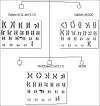46,XX, der(15),t(Y;15)(q12;p11) karyotype in an azoospermic male
- PMID: 23162305
- PMCID: PMC3491303
- DOI: 10.4103/0971-6866.100785
46,XX, der(15),t(Y;15)(q12;p11) karyotype in an azoospermic male
Abstract
We report on a Yq/15p translocation in a 23-year-old infertile male referred for Klinefelter Syndrome testing, who had azoospermia and bilateral small testes. Hormonal studies revealed hypergonadotropic hypogonadism. Conventional cytogenetic procedures giemsa trypsin giemsa (GTG) and high resolution banding (HRB) and molecular cytogenetic techniques Fluorescence In Situ Hybridization (FISH) performed on high-resolution lymphocyte chromosomes revealed the karyotype 46,XX, t(Y;15)(q12;p11). SRY-gene was confirmed to be present by classical Polymerase Chain Reaction (PCR) methods. His father carried de novo derivative chromosome 15 [45,X, t(Y;15)(q12;p11)] and was fertile; the karyotype of the father using G-band technique confirmed a reciprocal balanced translocation between chromosome Y and 15. In the proband, the der (15) has been inherited from the father because the mother had a normal karyotype (46,XX). In the proband, the der (15) could have produced genetic imbalance leading to unbalanced robertson translocation between chromosome Y and 15, which might have resulted in azoospermia and infertility in the proband. The paternal translocation might have lead to formation of imbalanced ova, which might be resulted infertility in the proband. Sister's karyotypes was normal (46,XX) while his brother was not analyzed.
Keywords: 46; Fluorescence In Situ Hybridization; XX male; Yq;15p translocation; azoospermia; infertility.
Conflict of interest statement
Figures



Similar articles
-
Prenatal diagnosis of a familial Y long-arm and chromosome 15 short-arm translocation inherited from a mother carrier.Taiwan J Obstet Gynecol. 2021 Jul;60(4):781-783. doi: 10.1016/j.tjog.2021.05.036. Taiwan J Obstet Gynecol. 2021. PMID: 34247826
-
Unique t(Y;1)(q12;q12) reciprocal translocation with loss of the heterochromatic region of chromosome 1 in a male with azoospermia due to meiotic arrest: a case report.Hum Reprod. 2005 Mar;20(3):689-96. doi: 10.1093/humrep/deh653. Epub 2005 Jan 21. Hum Reprod. 2005. PMID: 15665019
-
FISH and array CGH characterization of de novo derivative Y chromosome (Yq duplication and partial Yp deletion) in an azoospermic male.Reprod Biomed Online. 2015 Aug;31(2):217-24. doi: 10.1016/j.rbmo.2015.04.014. Epub 2015 May 7. Reprod Biomed Online. 2015. PMID: 26096031 Free PMC article.
-
Concomitance of 47,XXY, a balanced reciprocal translocation of t(4;17)(q12;q11.2) encompassing SPINK2 at 4q12 and NOS at 17q11.2 and an AZFa sY86 deletion in an infertile male.Taiwan J Obstet Gynecol. 2023 Mar;62(2):336-342. doi: 10.1016/j.tjog.2022.11.014. Taiwan J Obstet Gynecol. 2023. PMID: 36965905 Review.
-
Delineating the association between isodicentric chromosome Y and infertility: a retrospective study.Fertil Steril. 2014 Apr;101(4):1091-6. doi: 10.1016/j.fertnstert.2013.12.048. Epub 2014 Feb 4. Fertil Steril. 2014. PMID: 24502892 Review.
Cited by
-
Cytogenetic Investigation in a Group of Ten Infertile Men with Non-Obstructive Azoospermia: First Algerian 46, XX Syndrome.Iran J Public Health. 2016 Jun;45(6):739-47. Iran J Public Health. 2016. PMID: 27648416 Free PMC article.
-
A 46,XX Karyotype in Men with Infertility: Two New Cases and Review of the Literature.J Hum Reprod Sci. 2022 Jul-Sep;15(3):307-317. doi: 10.4103/jhrs.jhrs_100_22. Epub 2022 Sep 30. J Hum Reprod Sci. 2022. PMID: 36341017 Free PMC article.
-
46,XX Testicular Disorder of Sex Development (DSD): A Case Report and Systematic Review.Medicina (Kaunas). 2019 Jul 12;55(7):371. doi: 10.3390/medicina55070371. Medicina (Kaunas). 2019. PMID: 31336995 Free PMC article.
-
An azoospermic male with a novel chromosome 46, XX, der(15)t(Y; 15)(p11.3; p12).Clin Case Rep. 2022 Jul 11;10(7):e5984. doi: 10.1002/ccr3.5984. eCollection 2022 Jul. Clin Case Rep. 2022. PMID: 35846903 Free PMC article.
References
-
- Alitalo T, Tiihonen J, Hakola P, la Chapelle A. A Molecular characterization of a Y;15 translocation seggregating in a family. Hum Genet. 1988;79:29–35. - PubMed
-
- Powell C. Sex chromosomes and sex abnormalities. In: Gersen GL, Keagle MB, editors. The principles of clinical cytogenetics. Totowa NJ: Humana Press; 1999. pp. 229–58.
-
- Metzler-Guillemain C, Mignon C, Depetris D, Guichaoua MR, Mattei MG. Bivalent 15 regularly associates with the sex vesicle in normal male meiosis. Chromosome Res. 1999;7:369–78. - PubMed
-
- Neumann A, Robson L, Smith A. A 15p variant shown to be a t(Y;15) with fluorescence in situ hybridization. Ann Genet. 1992;5:227–30. - PubMed
-
- Fukada Y, Yasumizu T, Amemiya A, Kohno K, Takizawa M, Hoshi K, et al. Prenatal confirmation of the translocation between chromosome 15 and Y-chromosome by fluorescence in situ hybridization. Tohoku J Exp Med. 1999;187:285–9. - PubMed
Publication types
LinkOut - more resources
Full Text Sources

